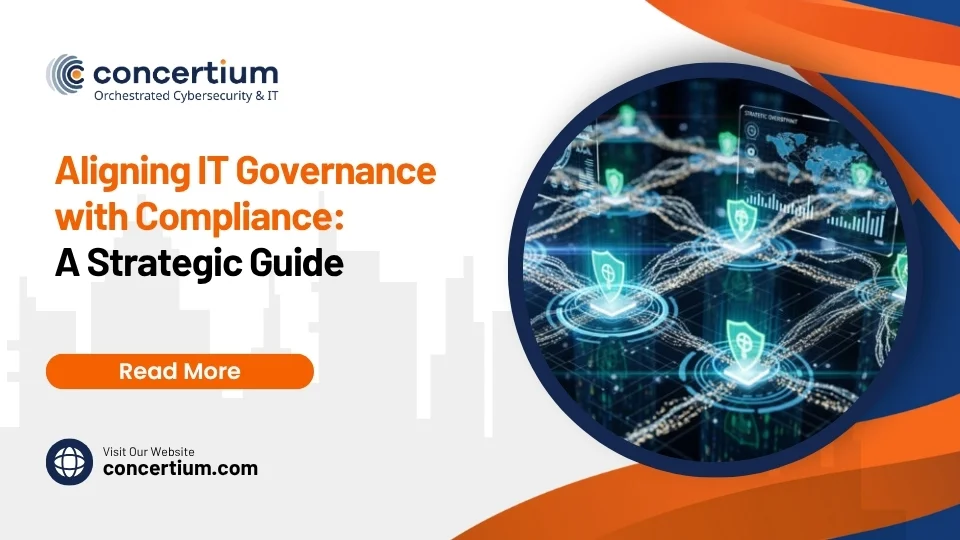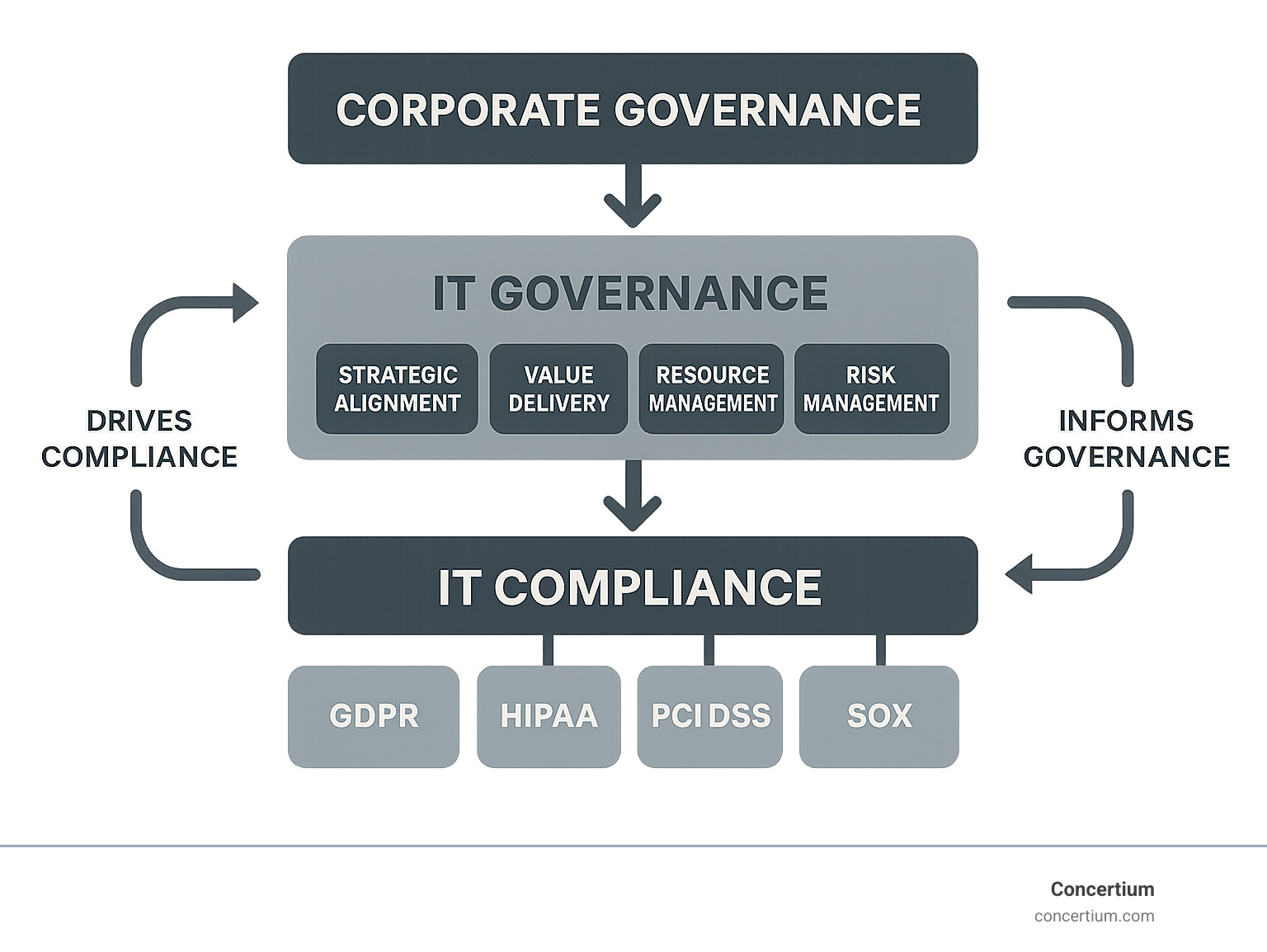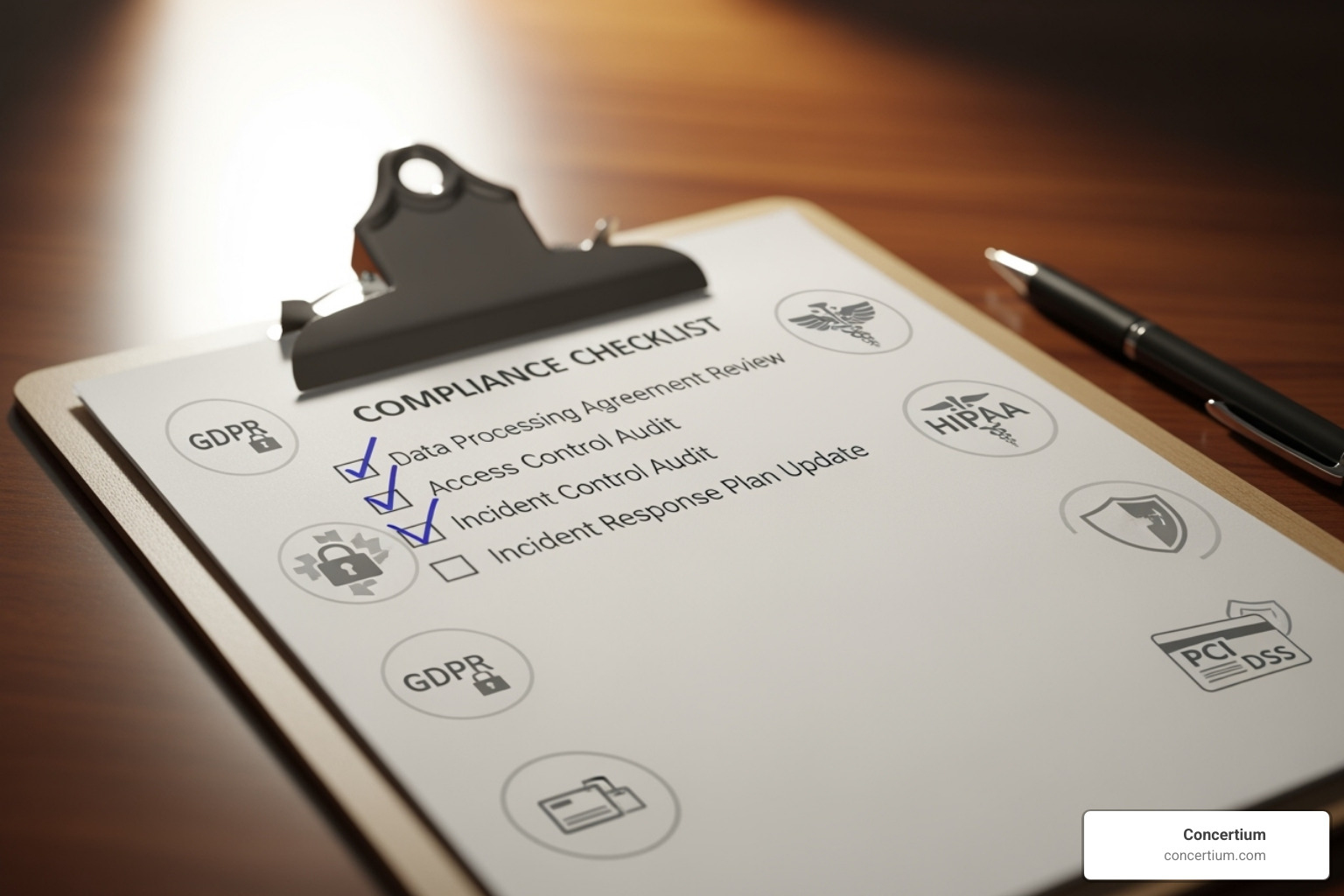IT governance and compliance create a powerful framework that protects your business while driving growth. In today’s digital landscape, understanding these concepts is essential for survival.
Quick Answer: IT Governance vs. IT Compliance
- IT Governance: Strategic framework that aligns technology with business goals, focuses on value creation, and takes a proactive approach to managing IT resources
- IT Compliance: Adherence to external laws, regulations, and industry standards to avoid penalties and legal issues
- Key Difference: Governance is about optimizing IT for business success, while compliance is about following required rules
- Relationship: Strong governance naturally supports compliance, but compliance alone doesn’t guarantee good governance
The numbers are compelling: research shows that firms with above-average IT governance performance had more than 20% higher profitability than firms with poor governance. Effective IT governance is the single most important predictor of the value an organization generates from IT.
For mid-sized enterprises, this presents both an opportunity and a challenge. You face increasing cyber threats, growing regulatory requirements, and pressure to do more with less. The question isn’t if you need governance and compliance, but how to implement them effectively.
As one industry expert noted: “In the dynamic landscape of business expansion and evolution, distinguishing between IT governance and compliance becomes not just beneficial, but essential.”
The stakes are high: non-compliance leads to severe penalties and risks, while poor governance wastes resources and misses opportunities for competitive advantage.
IT governance and compliance terms to remember:
Governance vs. Compliance: Understanding the Core Differences
Many leaders think IT governance and compliance are the same, but they’re not. Think of it like a GPS versus traffic laws: one shows you the destination, while the other provides the rules for the road.
IT governance is your strategic compass. It’s proactive and focused on making technology work for your business. Strong governance asks strategic questions: How can IT drive growth? Are we getting the best ROI on technology? Does our tech strategy support company goals?
Governance is your internal roadmap for value creation, ensuring every IT decision contributes to the bottom line. It’s flexible and adapts to your unique business needs.
IT compliance, on the other hand, is your rulebook. It’s reactive, responding to external demands from regulators and legal frameworks. It asks: “Are we following the rules?” The goal is risk avoidance—preventing fines, legal issues, and reputation damage.
Crucially, strong governance makes compliance easier. With solid processes, meeting regulatory requirements becomes a natural byproduct, not a scramble.
| Feature | IT Governance | IT Compliance |
|---|---|---|
| Focus | Strategic alignment, value creation, optimization | Adherence to external rules, risk avoidance (penalties) |
| Objective | Ensure IT supports and drives business goals | Meet legal, regulatory, and industry mandates |
| Scope | Internal policies, processes, decision-making | External laws, regulations, industry standards |
| Flexibility | More adaptable to organizational needs, long-term | Strict adherence to set rules, often short-term |
What is IT Governance?
IT governance is a core part of your corporate strategy, designed to make technology work for you in ways that directly impact success and profitability.
Governance means every IT decision is guided by a clear framework asking, “Will this help us achieve our business goals?” It’s about enhancing IT performance and maximizing value from every tech investment.
Its long-term strategic outlook means you prevent problems instead of just fixing them. It establishes clear decision-making, defines responsibilities, and creates mechanisms to measure IT results.
This internal focus means governance adapts to your unique vision. What works for a healthcare company might not work for a manufacturing firm, and that’s perfectly fine. Your governance framework should fit your business like a custom suit.
For organizations ready to take their risk management to the next level, our comprehensive guide on Mastering Risk Management & Compliance Strategies provides the roadmap you need.
What is IT Compliance?
IT compliance looks outward at the mandatory rules you must follow. These aren’t suggestions; they’re mandates from external bodies with real consequences.
Think about regulations like HIPAA requirements for healthcare or GDPR obligations for European customer data. Each comes with specific technical requirements and hefty penalties for non-compliance.
Compliance has an external focus and is rigid. You can’t negotiate with regulations like GDPR or HIPAA; you must follow the rules.
However, when approached strategically through governance, compliance builds trust with customers and partners who value data security.
Whether you’re dealing with healthcare data protection through HIPAA Data Loss Prevention, navigating European privacy laws with GDPR Compliance in Cybersecurity, or understanding the broader landscape through our guide on What is Data Security Compliance?, the key is building these requirements into your overall IT strategy.
The Strategic Imperative of Strong IT Governance
IT governance and compliance are more than just defensive measures; they are powerful engines for business success, turning IT from a cost center into a strategic powerhouse.
Proper IT governance delivers unmistakable business value. Stakeholders see IT as a reliable, secure asset that contributes to organizational goals, building confidence and increasing ROI.
The numbers prove it: firms with strong IT governance have over 20% higher profitability than those with poor governance, creating a significant competitive advantage.
Beyond profits, effective governance is your first line of defense against risk. Proactively managing IT risks protects you from cyber threats, data breaches, and operational disruptions. That’s why CEOs rank managing IT risk as their second-highest priority.
For a deeper look at how we approach managing these cybersecurity risks, explore our insights on Cybersecurity Risk Management Frameworks.
Key Objectives of IT Governance
The objectives of IT governance work together to ensure IT actively supports and improves your overall business performance. These are the five pillars of your IT strategy.
Strategic alignment ensures IT strategy is synchronized with business objectives, making IT a true strategic partner.
Value delivery focuses on ensuring every IT investment generates tangible benefits, optimizing processes, and maximizing ROI.
Resource management ensures the efficient and effective use of all IT resources (infrastructure, applications, people) without waste.
Risk management proactively identifies, assesses, and mitigates IT-related risks, from cyber threats to system failures, to protect assets and ensure business continuity.
Performance measurement establishes clear metrics to monitor IT performance, track progress, and demonstrate its value to the organization.
These objectives form the foundation of effective IT governance, risk, and compliance (IT GRC). For more information on our integrated approach, visit our page on IT Governance, Risk, and Compliance (IT GRC).
How Governance Drives Regulatory Compliance
While compliance is about following rules, IT governance provides the proactive framework that makes it feel effortless. It’s the difference between scrambling to meet a deadline and having a well-oiled machine that produces compliant results.
Effective IT governance establishes the controls, policies, and procedures that streamline regulatory compliance. Clear data handling policies and access controls, for example, make it easier to meet GDPR, HIPAA, or PCI DSS requirements.
Governance also mandates detailed audit trails, ensuring the transparency and accountability needed for regulatory audits. It builds a system that naturally produces the required evidence.
This approach integrates compliance into daily IT operations, making it an inherent outcome of good governance. It proactively identifies potential compliance gaps before they become costly problems.
For specific guidance on regulatory adherence, check out our resources on PCI Compliance Risk Assessment. Our expertise in Automated Compliance Monitoring can streamline these processes, making compliance a continuous, integrated activity.
Building a Resilient Framework: Key Components and Standards
Building a solid IT governance and compliance framework requires a custom blueprint. There’s no one-size-fits-all solution; the best approach blends elements from different standards to fit your unique needs.
Your framework must cover five core domains: Strategic Alignment, Value Delivery, Risk Management, Resource Management, and Performance Management. These ensure IT supports goals, delivers value, protects against threats, uses assets efficiently, and measures results. When these pieces work in harmony, organizations see streamlined operations and better security, as highlighted in our guide on Cybersecurity Compliance Services: Top 3 Benefits.
Popular IT Governance and Compliance Frameworks
Choosing the right framework for IT governance and compliance can feel overwhelming, but each major option brings something valuable. The key is understanding what each does best.
COBIT is a comprehensive framework for aligning IT with business goals, managing risk, and ensuring compliance.
ITIL focuses on how to manage IT services effectively, complementing governance with its focus on service delivery and operational excellence.
ISO/IEC 38500 provides high-level principles for boards and senior leaders to oversee IT use responsibly.
COSO offers a broad perspective on internal controls and enterprise risk management, valuable for financial and regulatory controls in IT.
NIST frameworks offer practical guidelines for managing cybersecurity risks and are often used as benchmarks for security and compliance.
The magic happens when you combine elements from multiple frameworks. For instance, you might use COBIT for governance, ITIL for service management, and NIST for cybersecurity. Our Risk and Compliance Tools Guide can help you find the right combination for your organization.
The Critical Role of Risk Management
Risk management is the foundation of your IT governance and compliance framework. Without it, even the best structures can crumble.
Risk management is a continuous process, not a one-time assessment. It begins with identifying vulnerabilities across your IT landscape, including processes and training gaps.
Assessing their potential impact is the next step. This prioritization helps focus resources on the most critical threats to your business.
Developing mitigation strategies can involve new technology, updated policies, or better training. The goal is to strengthen governance while addressing specific risks.
Continuous monitoring is essential. The threat landscape is always changing, and ongoing vigilance helps catch new threats and ensures controls remain effective.
Effective risk management protects assets, maintains business continuity, and makes compliance manageable. For detailed guidance, check out our Compliance Risk Assessment: 5 Essential Expert Tips. For more comprehensive support, our Risk & Compliance Advisory services can help you build a program that works.
An Actionable Roadmap for Effective IT Governance and Compliance
Implementing IT governance and compliance is like planning a road trip: you need a map, a plan, and clear roles. The destination is a robust, compliant organization protected from risk and positioned for growth.
Executive buy-in is critical. Without leadership support, initiatives fail. Highlighting the potential for a 20% profitability boost helps secure this support. Next, define roles and responsibilities for clear accountability. Continuous improvement keeps your framework relevant, and fostering collaboration between IT and business teams turns governance into a strategic advantage.
For organizations dealing with complex regulatory requirements, GRC Automation Tools can be game-changers, freeing your team to focus on strategic initiatives.
Best Practices for Implementation
Here’s what makes the difference between success and frustration.
Clear responsibilities: Ensure everyone knows their role to create natural accountability.
Stakeholder involvement: Involve stakeholders from legal, operations, and other departments early to gain diverse perspectives and avoid costly mistakes.
Regular audits: Conduct regular audits as an early warning system to proactively identify issues.
Automation tools: Use automation to reduce manual work, enforce policies consistently, and free up your team for strategic tasks.
Continuous review: Regularly review your framework to adapt to new regulations, threats, and business changes.
IT-business collaboration: Promote collaboration between IT and business teams to align technology projects with strategic goals.
Measuring Effectiveness and Overcoming Challenges
To measure effectiveness, track the right numbers. Use Key Performance Indicators (KPIs) like ROI on IT investments, project alignment with business goals, and incident metrics to measure the value of your governance program.
However, the road isn’t always smooth. Common challenges include:
- Resistance to change: Overcome this by involving stakeholders in the design process to foster buy-in.
- Resource constraints: This requires careful prioritization. Focus on high-impact areas first to build momentum.
- Lack of alignment: Bridge the gap between IT and business with regular communication and shared metrics.
- Complexity: Manage this by starting simple. Address the most critical areas first; good governance now is better than perfect governance later.
The Impact of Emerging Technologies like AI
Artificial Intelligence is reshaping IT governance and compliance, acting as a powerful assistant for processing information and automating tasks.
AI in policy creation can suggest components based on your industry and regulations, accelerating the process.
AI-powered control monitoring makes compliance proactive by spotting patterns and flagging issues early.
AI-driven risk analysis processes vast data sets to identify vulnerabilities and predict threats more effectively.
However, AI also introduces new governance challenges, including the need for policies on AI use, fairness, privacy, and human oversight.
The key is embracing AI’s benefits while building appropriate guardrails. It’s about augmenting human judgment with powerful tools to make better, faster decisions.
Frequently Asked Questions about IT Governance and Compliance
We’ve helped countless organizations steer the complexities of IT governance and compliance. Here are answers to the questions that come up most often.
What is the difference between IT governance and IT management?
This is a common question, as the terms sound similar but are quite different.
IT governance is the strategic compass for technology. It asks what IT should do and why, setting direction, defining accountability, and ensuring IT delivers value while managing risk.
IT management is the operational crew that handles the how. It focuses on the day-to-day delivery of IT services, project execution, and system maintenance. Management executes the strategy that governance sets.
In short: governance ensures you’re doing the right things; management ensures you’re doing things right.
What is the most common IT governance framework?
For IT governance and compliance, a great starting point is COBIT (Control Objectives for Information and Related Technologies), the most widely used and comprehensive framework.
Developed by ISACA, COBIT is popular for its practical, actionable guidance on aligning technology with business goals, managing risk, and ensuring compliance. Its process-oriented nature makes it adaptable for companies of all sizes. COBIT effectively bridges the gap between business needs and IT delivery, helping align the entire organization.
How does strong IT governance improve an organization’s profitability?
Strong IT governance directly impacts the bottom line. Companies with strong governance see over 20% higher profitability. Here’s how:
- Better IT investments: Your framework ensures every tech project supports business objectives, eliminating wasteful spending and focusing on investments with measurable ROI.
- Improved efficiency: Good governance streamlines IT processes and eliminates redundancies, freeing up your team for strategic, growth-focused initiatives.
- Risk reduction: Proactive risk management minimizes costly security breaches, system failures, and regulatory fines, protecting your profits from significant financial and reputational damage.
- Better decision-making: A clear framework leads to informed, strategic IT choices based on business goals, not gut feelings, resulting in better outcomes.
- Increased business agility: A well-governed IT environment allows you to adapt quickly to market changes and leverage new technologies, providing a significant competitive edge.
The bottom line? Strong IT governance transforms technology from a necessary expense into a strategic asset that actively drives profitability and growth.
Conclusion
IT governance and compliance are more than corporate checkboxes; they are the foundation for changing technology from a cost center into a profit-driving engine.
When governance and compliance work in harmony, your technology becomes proactive. You move from fixing problems to making strategic decisions that propel your business forward.
This synergy creates business resilience, allowing your organization to adapt to change and seize opportunities. Your IT infrastructure becomes a strategic asset and a true competitive edge.
However, navigating the complex landscape of regulations and frameworks can be overwhelming while running a business.
That’s where experience makes all the difference. At Concertium, we’ve spent nearly 30 years helping organizations like yours steer these complexities.
Our approach recognizes that IT governance and compliance isn’t one-size-fits-all. Our Collective Coverage Suite (3CS), featuring AI-improved observability and automated threat eradication, provides custom solutions custom to your unique business needs.
We avoid cookie-cutter solutions, working with you to build robust, flexible frameworks. Our goal is to turn your IT into a competitive advantage that drives growth and protects your assets.
Ready to transform how your organization approaches technology governance? Find how we can support your Governance, Risk, and Compliance (GRC) Management needs. Together, we can build the secure, efficient, and profitable future your business deserves.






